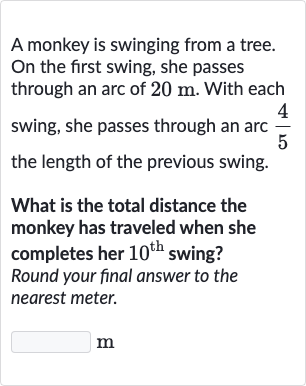AI tutor
Welcome to Bytelearn!
Let’s check out your problem:

A monkey is swinging from a tree. On the first swing, she passes through an arc of . With each swing, she passes through an arc the length of the previous swing.What is the total distance the monkey has traveled when she completes her swing?Round your final answer to the nearest meter.
Full solution
Q. A monkey is swinging from a tree. On the first swing, she passes through an arc of . With each swing, she passes through an arc the length of the previous swing.What is the total distance the monkey has traveled when she completes her swing?Round your final answer to the nearest meter.
- Identify Swing Lengths: Identify the sequence of the lengths of the swings.The monkey swings through an arc of on the first swing. Each subsequent swing is times the length of the previous swing. This creates a geometric sequence for the lengths of the swings.First swing length = Second swing length = Third swing length = ...Tenth swing length =
- Calculate Total Distance: Calculate the total distance traveled by summing the lengths of the swings.The total distance is the sum of the first terms of the geometric sequence.Total distance =
- Use Geometric Sequence Formula: Use the formula for the sum of the first terms of a geometric sequence.The sum of the first terms of a geometric sequence is given by:, where is the first term, is the common ratio, and is the number of terms.Here, , , and .
- Calculate Sum: Calculate the sum using the values for a, r, and n.
- Round Final Answer: Round the final answer to the nearest meter.The total distance traveled, rounded to the nearest meter, is approximately meters.
More problems from Circles: word problems
QuestionGet tutor help
QuestionGet tutor help
QuestionGet tutor help
QuestionGet tutor help
QuestionGet tutor help
QuestionGet tutor help
QuestionGet tutor help
QuestionGet tutor help
QuestionGet tutor help
